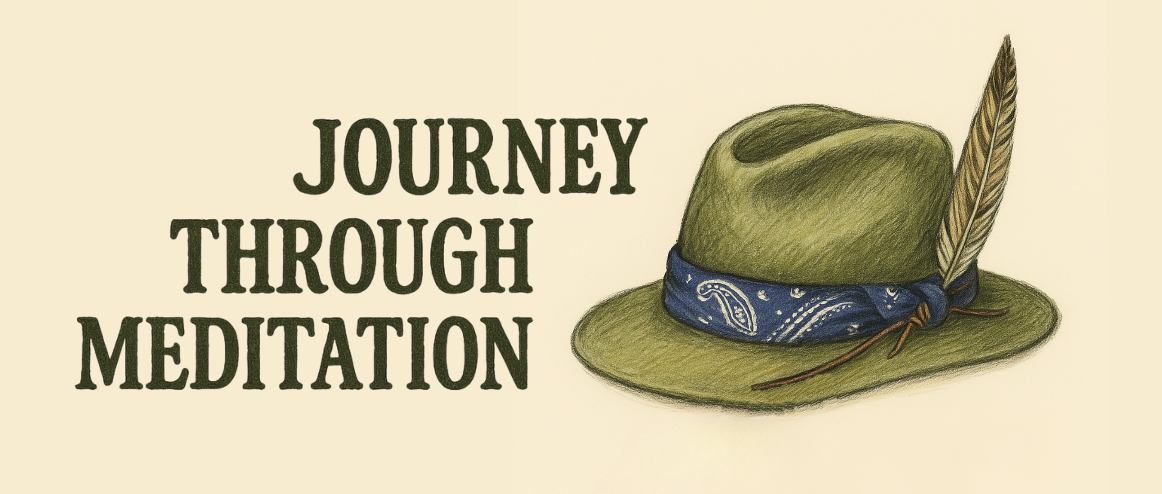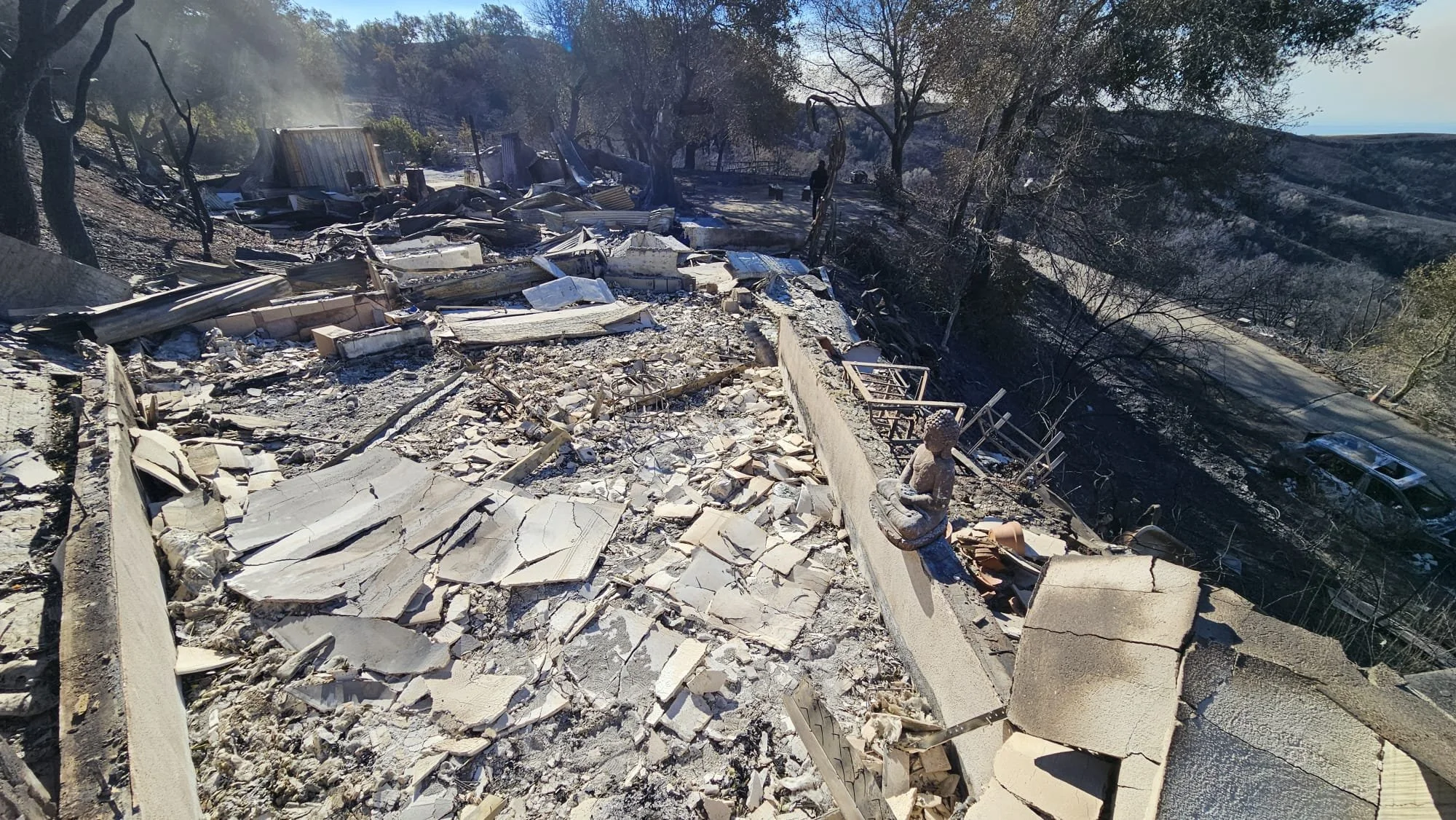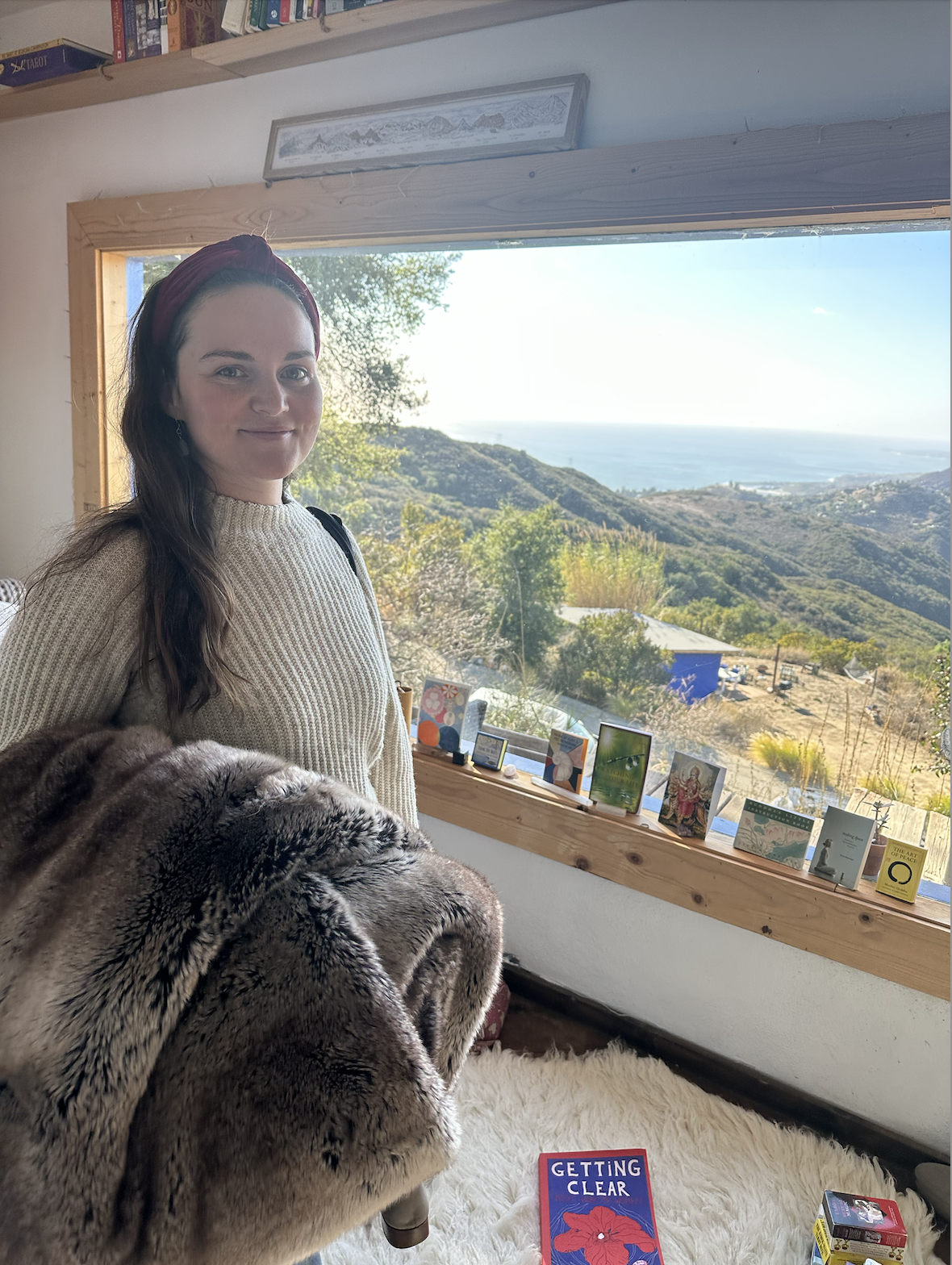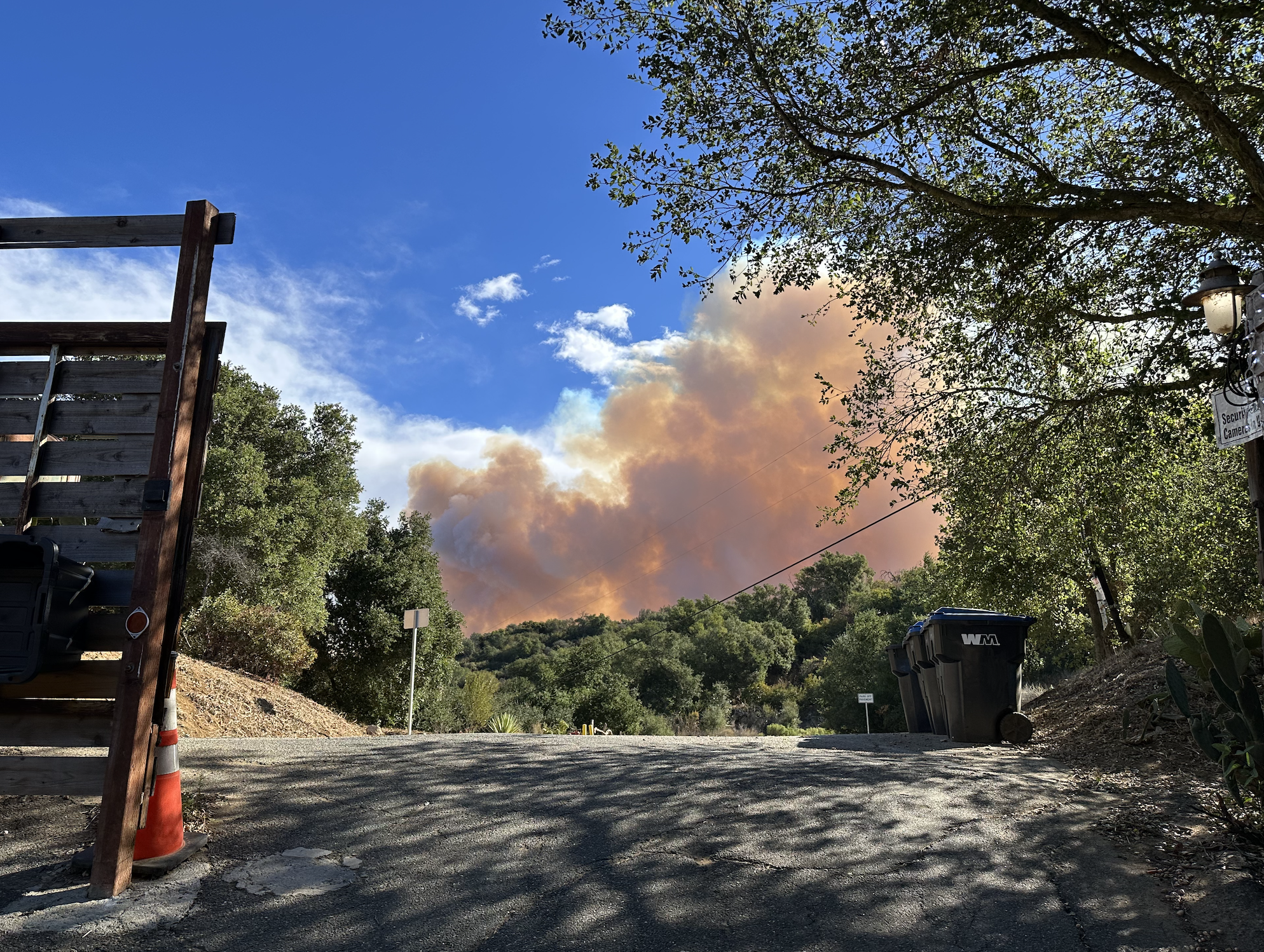Your Custom Text Here
Embracing Impermanence: Lessons from Losing Nearly Everything
Losing my Topanga home to the Palisades Fire has been a heart-wrenching journey, but it’s also been a profound lesson in impermanence and resilience. Among the ashes, I found two items untouched: a Buddha statue and a lava-formed obelisk crystal. These symbols of serenity and transformation remind me that even in loss, there is an opportunity for spiritual growth and renewal.
The Palisades Fire has left a trail of devastation across Los Angeles, turning dreams into ashes and lives into stories of resilience. Among the countless homes that fell victim to the flames, the magical Topanga sanctuary my girlfriend and I shared—a space filled with love, creativity, and spiritual practice—was reduced to rubble. The space was a manifestation of my deepest values and passions.
With its breathtaking view of the valley and Pacific Ocean, it was a place where inspiration thrived, where life felt balanced and meaningful. But in the blink of an eye, it was gone, along with nearly all my possessions.
Inventory of What I Lost
When I think about what I lost, it feels like an inventory of my soul:
Between 50 and 100 cherished spiritual books that shaped my understanding and growth.
Years of meticulous research stored in binders, notecards, and notebooks.
Essential files, important paperwork, and deeply personal writings.
Every piece of clothing and shoe I owned.
The tools of my daily life—kitchenware, furniture, rugs, and decorations.
Artwork I had poured my heart into creating.
My meditation cushion, yoga mat, and yoga blankets, which supported my daily practice.
Sacred altar items, symbols of my spiritual journey.
My harmonium, a vessel for musical meditation.
Handmade pottery, carrying the marks of creativity and presence.
Each of these items carried memories and meaning. Yet, in their absence, I find myself standing at a profound crossroads.
What I Saved
Amidst the ruins, there were a few things I managed to save. They feel like small miracles, reminders of what truly endures:
The clothes on my back and the essential tools of my daily work—my laptops and headphones.
A single deck of tarot cards and the first physical copy of my Journey Through Meditation book, now more meaningful than ever.
A picture of my meditation teacher and an altar item gifted by him, symbolic of spiritual guidance that transcends the material.
My guitar, an instrument of expression and solace.
My passport, essential for travel.
These items saved are a blessing that are now more meaningful than ever and a reminder of what is most essential to me.
What Survived
Amidst the ashes of my home, two items left behind survived the fire—a Buddha statue and an obelisk crystal.
The Buddha statue, once the centerpiece of my meditation altar, remained steadfast among the rubble. Its survival felt like a profound reminder of the teachings I hold closest: the impermanence of life, the practice of non-attachment, and the strength that comes from inner peace. Despite the destruction surrounding it, the statue exuded an unshakable serenity, grounding me in the present and reminding me that true refuge lies within.
My girlfriend’s black obelisk crystal, left behind in the bedroom, was a striking formation born from the fiery force of molten lava. This crystal, with its sharp lines and powerful presence, seemed to symbolize resilience and transformation. It felt like a message from the universe, a testament to the idea that beauty and strength can emerge from intense heat and pressure.
Lessons in Impermanence
Losing so much at once is an unthinkable tragedy, but it is also an unparalleled lesson in the central teaching of impermanence. Meditation has always been my anchor—a practice that teaches us to detach from material possessions and find peace within. Yet, this experience is testing the depth of my understanding in ways I could not have imagined.
When the external world is stripped away, the inner world becomes all the more critical. I’ve realized that the most meaningful possessions—the ones I cannot lose—are the practices, lessons, and inner peace cultivated through years of dedication.
This fire left me grieving, but it also left me humbled. It has invited me to let go, not just in theory but in action, to find a deeper level of non-attachment and embrace the profound truth that peace comes from within.
Moving Forward
Rebuilding takes time. But I’m bouncing back faster than I ever could have imagined. My Journey Through Meditation book (available right now in ebook form), which I held in my hands as I fled the fire, feels like a symbol of what I still have to offer—a beacon for myself and others navigating life’s storms.
Already, so many friends, family, and employers have supported my girlfriend and I in our transition process by offering us support in the form of money, ebook sales, food, clothes, and places to live.
To anyone reading this, I invite you to reflect on the impermanence in your life. What are the possessions or attachments you hold onto? What remains when they are stripped away? Let this be a reminder to cherish what truly matters and to find stability within yourself, no matter the external chaos.
The journey continues, one step, one breath, and one moment at a time.
Finding Peace Amid Devastation from Palisades Fire
Losing my Topanga home in the Palisades Fire has been an unimaginable heartbreak. Amid the ashes, only a serene Buddha statue remained, a powerful symbol of non-attachment, resilience, and inner peace. This tragedy has deepened my understanding of gratitude—finding appreciation for what remains and the lessons life continues to offer, even in the face of profound loss.
My rustic and magical home in Topanga—a place my girlfriend and I dreamed of and cherished for its breathtaking views of the valley and the Pacific Ocean—was among those lost in the Los Angeles fires this week.
As many of you know, the recent Palisades Fire has devastated large parts of Los Angeles, including the Palisades, Topanga, Malibu, and Pasadena areas. This wildfire has damaged over 9,000 structures, making it the most destructive in LA’s history.
Amid the rubble, only one thing remained: a serene Buddha statue, gazing calmly through the chaos. It became a powerful symbol for me.
Turning Loss into Growth
While losing my home and cherished belongings has been a heartbreaking experience, it has also reinforced the core teachings of meditation:
Non-Attachment: Letting go of what we cannot hold forever.
Resilience: Finding strength in life’s challenges.
Inner Peace: Discovering stability within ourselves, not in external circumstances.
These are the same principles I share in my ebook, Journey Through Meditation. This guide reflects the practices and lessons that have supported me through this unimaginable time.
Pictures
Our majestic views! 🥹
Me - before tragedy struck.
Katy - the day of departure.
The sunsets we enjoyed every night!
Ominous clouds approaching...
Evacuation time!
A Moment of Gratitude
I want to thank my family - my parents and my sisters (Lindsey and Annie), and my extended family and new members of my family (Joaquin) who have supported me throughout this hardship and helped me spread the word about my ebook. I especially want to thank Katy, my girlfriend, who has been living with me and who I evacuated with - it’s the second time in six months that external circumstances have forced us both out of a home. ❤️
The Case for a Flexible Spiritual Practice When Life Gets Overwhelming
Life isn’t a series of perfect routines—it’s a dynamic, unpredictable journey. While spiritual practices like meditation and yoga can ground us, it’s just as vital to embrace flexibility when life disrupts those routines. Missing a practice doesn’t diminish your spirituality; instead, it offers an opportunity to practice self-compassion.
We often judge ourselves harshly for not maintaining our routines, especially spiritual practices like meditation and yoga. But it’s crucial to show ourselves kindness and flexibility when we miss a practice.
Life is chaotic, unpredictable, and full of disruptions—career changes, moving, holidays, relationships, hobbies, and countless other demands. It's natural to have weeks where maintaining a routine feels impossible.
Even as someone who has practiced meditation for ten years and guides others in their understanding of the practice, I sometimes miss practice sessions and go through periods where my routines are less consistent than others.
Here’s what disrupted my spiritual practices this week:
Moving into a new house: unpacking, cleaning, and setting up furniture.
Starting a new job.
Taking on extra responsibilities at work.
Holiday shopping.
Cooking and meal prep.
Why Is There So Much Judgment?
Many spiritual practices and teachings were created in vastly different times and for very different contexts. Even books from just 30 years ago predate the digital age—no smartphones, no constant connectivity.
Modern life demands a level of adaptability that older frameworks might not account for. If your spiritual practices feel rigid or stressful, they’re working against their very purpose: to bring peace and relaxation.
Remember, life itself can be a meditation. The guru isn’t just on the mat or cushion—it’s everywhere. Whether in traffic, at work, or during a heated conversation, mindfulness can turn any moment into a spiritual practice.
Compassion as an Antidote to Judgment
When you miss a practice, self-compassion is key.
For many, love and compassion are the highest spiritual practices. Instead of treating spirituality like a checklist—where completing tasks makes you “good” or “worthy”—reframe it. Ask yourself: How can I be more loving to myself in this moment?
Spirituality isn’t about perfection — it’s about connection. And sometimes, the most spiritual act is to offer yourself grace.
Build a Spiritual Toolkit
Flexibility doesn’t mean abandoning structure entirely—it’s about creating a toolkit of practices to draw from based on what each day demands.
Feeling judgmental? Try a loving-kindness meditation.
Feeling anxious? Focus on your breath.
Feeling restless? Take a walking meditation in nature.
This adaptable approach often holds more value than rigidly sticking to the same practice every day. After all, it’s not uncommon to see yogis who religiously stick to their mats but lack kindness in their interactions. Or lifelong meditators who have yet to find peace.
The Hybrid Approach: Best of Both Worlds
There are seasons when a consistent routine can be deeply beneficial.
I often go through three-month periods of structured practice—whether it’s 60 minutes of Ashtanga yoga every morning, 20 minutes of meditation twice daily, or 15 minutes of qigong after work— only to see that structure completely flipped on end as the circumstances of my life demand something different.
I once asked my spiritual teacher, Mark, “What if my practice isn’t the right length?” He replied, “Pick a duration that feels right for your current circumstances. Then, in a few months, do an audit.”
I’ve found in my own life that, time and again, this is just what’s needed. As an example, in recent times, I had a very structured Ashtanga yoga practice going for 60 minutes every morning. I used to practice outside because my previous living situation lacked indoor practice space. But then the season changed and it was too cold to practice outside.
Additionally, I had to pick up an additional, quite physically demanding, temporary to job to help me keep up with my bills and cover some of my recent moving expenses, and I found that I was overexerting myself by continuing the yoga whilst pursuing this other job. So, I decided to omit my yoga just for the time being and focus on practices and routines that were less active and more restorative.
So, the key is to commit to what works for you while staying open to change. Life is always in flux, and judgment only adds unnecessary weight.
Practices Are Not the Destination
Routines and practices are tools—they point us toward connection and presence, but they are not the destination.
True spirituality lies in the here and now: being present with yourself, your spirit, and your surroundings. Whether you’re stuck in traffic, navigating workplace challenges, or simply sitting at home, every moment holds an opportunity to connect.
So, let life be your practice. Show up for it as it is—with all its messiness and unpredictability. After all, what could be more spiritual than embracing the wholeness of life itself?














